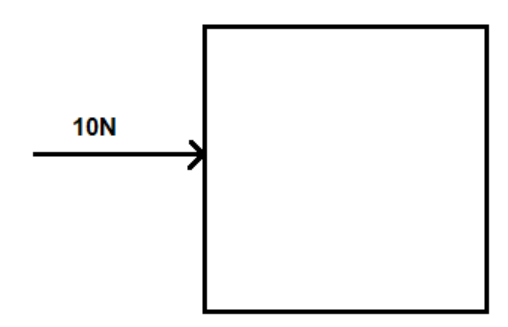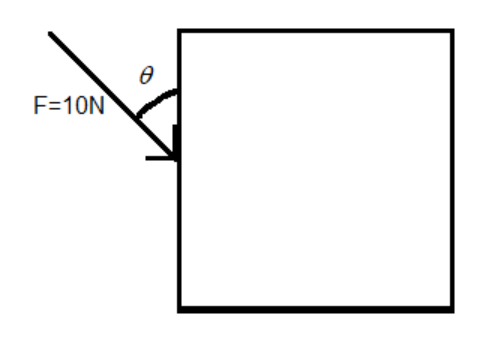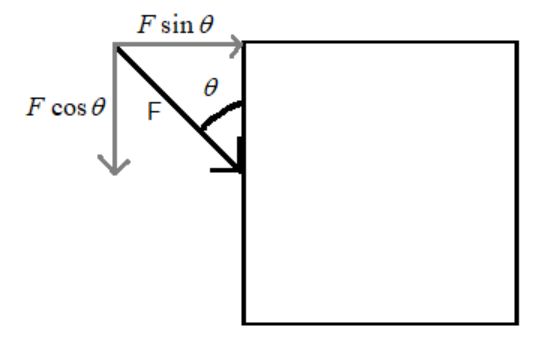
Fill in the blank.
The force acting on a unit area of a surface is called _ _ _ _ _.
A. atmospheric pressure
B. pressure
C. muscular force
D. none of these
Answer
583.2k+ views
Hint: Find out the definition or meaning of each of the given options and then check with which one does the given statement match. It is obvious that one of the options is incorrect. However, you may get confused between the remaining two options.
Formula used:
$\text{Pressure = }\dfrac{\text{perpendicular force}}{\text{area}}$
Complete step by step answer:
The force acting on a unit area of a surface is called pressure.
Hence, the correct option is (B) pressure.
Additional Information: To be precise, pressure is defined as the force acting perpendicular to the plane of a surface, on a unit area of the surface. If the normal force acting on the surface is uniform then the pressure on the surface is simply force upon the area of the surface perpendicular to the force.
i.e. $\text{Pressure = }\dfrac{\text{perpendicular force}}{\text{area}}$ .
For example, if a perpendicular force of 10N is acting on one side of cube with surface area of each side equal to $5{{m}^{2}}$ then the pressure (P) exerted on it is $P=\dfrac{\text{perpendicular force}}{\text{area}}=\dfrac{10}{5}=2N{{m}^{-2}}$.
We can also depict this by a diagram as shown.

If the force is not normal to the plane of the surface then we take the component normal to the plane into consideration.
To understand this, consider the same example given above except this time the force not perpendicular to the surface of the side. The force is acting at an angle $\theta $ (as shown below).

In this case, we have to consider that component of the force, which is perpendicular to the surface. For this we have to resolve the force into its components (as shown). By geometry the components of the force F will be $F\cos \theta $ and $F\sin \theta $.

Hence, the perpendicular force to the surface is $F\sin \theta $. Therefore, in this case the pressure on the side of the cube is $\dfrac{F\cos \theta }{A}=\dfrac{10\cos \theta }{5}=2\cos \theta N{{m}^{-2}}$.
The SI unit of pressure is called pascal. That is 1$N{{m}^{-2}}$ is equal to 1 pascal.
Now, the question is whether pressure is a scalar quantity or a vector quantity. While calculating only the component of the force that is normal to the surface, on which it is acting, is taken. Therefore, the direction of the original force does not matter. We need to know only the magnitude of the component of the force normal to the surface. Therefore, pressure does not have any specific direction. Hence, it is a scalar quantity.
Note: Let us now discuss the incorrect options.
(i) Atmospheric pressure: The pressure exerted by the particles of air on the surroundings. One might say that the answer to the given question can be atmospheric pressure also. However, atmospheric pressure is a type of pressure. We cannot generalise it for the definition of the pressure.
(ii) Muscular force: muscular force is the force exerted by the muscles. Obviously, this cannot be the answer to the question since the force acting on a unit area cannot be the force itself.
Formula used:
$\text{Pressure = }\dfrac{\text{perpendicular force}}{\text{area}}$
Complete step by step answer:
The force acting on a unit area of a surface is called pressure.
Hence, the correct option is (B) pressure.
Additional Information: To be precise, pressure is defined as the force acting perpendicular to the plane of a surface, on a unit area of the surface. If the normal force acting on the surface is uniform then the pressure on the surface is simply force upon the area of the surface perpendicular to the force.
i.e. $\text{Pressure = }\dfrac{\text{perpendicular force}}{\text{area}}$ .
For example, if a perpendicular force of 10N is acting on one side of cube with surface area of each side equal to $5{{m}^{2}}$ then the pressure (P) exerted on it is $P=\dfrac{\text{perpendicular force}}{\text{area}}=\dfrac{10}{5}=2N{{m}^{-2}}$.
We can also depict this by a diagram as shown.

If the force is not normal to the plane of the surface then we take the component normal to the plane into consideration.
To understand this, consider the same example given above except this time the force not perpendicular to the surface of the side. The force is acting at an angle $\theta $ (as shown below).

In this case, we have to consider that component of the force, which is perpendicular to the surface. For this we have to resolve the force into its components (as shown). By geometry the components of the force F will be $F\cos \theta $ and $F\sin \theta $.

Hence, the perpendicular force to the surface is $F\sin \theta $. Therefore, in this case the pressure on the side of the cube is $\dfrac{F\cos \theta }{A}=\dfrac{10\cos \theta }{5}=2\cos \theta N{{m}^{-2}}$.
The SI unit of pressure is called pascal. That is 1$N{{m}^{-2}}$ is equal to 1 pascal.
Now, the question is whether pressure is a scalar quantity or a vector quantity. While calculating only the component of the force that is normal to the surface, on which it is acting, is taken. Therefore, the direction of the original force does not matter. We need to know only the magnitude of the component of the force normal to the surface. Therefore, pressure does not have any specific direction. Hence, it is a scalar quantity.
Note: Let us now discuss the incorrect options.
(i) Atmospheric pressure: The pressure exerted by the particles of air on the surroundings. One might say that the answer to the given question can be atmospheric pressure also. However, atmospheric pressure is a type of pressure. We cannot generalise it for the definition of the pressure.
(ii) Muscular force: muscular force is the force exerted by the muscles. Obviously, this cannot be the answer to the question since the force acting on a unit area cannot be the force itself.
Recently Updated Pages
Master Class 11 Chemistry: Engaging Questions & Answers for Success

Why are manures considered better than fertilizers class 11 biology CBSE

Find the coordinates of the midpoint of the line segment class 11 maths CBSE

Distinguish between static friction limiting friction class 11 physics CBSE

The Chairman of the constituent Assembly was A Jawaharlal class 11 social science CBSE

The first National Commission on Labour NCL submitted class 11 social science CBSE

Trending doubts
What is meant by exothermic and endothermic reactions class 11 chemistry CBSE

10 examples of friction in our daily life

One Metric ton is equal to kg A 10000 B 1000 C 100 class 11 physics CBSE

Difference Between Prokaryotic Cells and Eukaryotic Cells

What are Quantum numbers Explain the quantum number class 11 chemistry CBSE

1 Quintal is equal to a 110 kg b 10 kg c 100kg d 1000 class 11 physics CBSE




